
Under the Whyte notation for the classification of steam locomotives, 4-6-2 represents the wheel arrangement of four leading wheels on two axles, six powered and coupled driving wheels on three axles and two trailing wheels on one axle. The 4-6-2 locomotive became almost globally known as a Pacific type after a New Zealand locomotive that was shipped across the Pacific Ocean.
The Southern Railway took a key role in expanding the 660 V DC third rail electrified network begun by the London & South Western Railway. As a result of this, and its smaller operating area, its steam locomotive stock was the smallest of the 'Big Four' companies.

Beyer, Peacock and Company was an English railway locomotive manufacturer with a factory in Openshaw, Manchester. Founded by Charles Beyer, Richard Peacock and Henry Robertson, it traded from 1854 until 1966. The company exported locomotives, and machine tools to service them, throughout the world.

The Eastern Railway is the main railway route between Fremantle and Northam in Western Australia. It opened in stages between 1881 and 1893. The line continues east to Kalgoorlie as the Eastern Goldfields Railway.

Western Australian Government Railways (WAGR) was the operator of railway services in the state of Western Australia between October 1890 and June 2003. Owned by the state government, it was renamed a number of times to reflect extra responsibility for tram and ferry operations that it assumed and later relinquished. Westrail was the trading name of WAGR from September 1975 until December 2000, when the WAGR's freight division and the Westrail name and logo were privatised. Its freight operations were privatised in December 2000 with the remaining passenger operations transferred to the Public Transport Authority in July 2003.

The WAGR X class is a now-withdrawn class of diesel locomotives built by Beyer, Peacock & Company and Metropolitan-Vickers, Bowesfield Works, Stockton-on-Tees for the Western Australian Government Railways (WAGR) between 1954 and 1956. Several members of the class have been preserved.

The WAGR D class was a class of 4-6-4T tank locomotive operated by the Western Australian Government Railways (WAGR) between 1912 and 1964.

The WAGR Dm class was a class of 4-6-4T tank locomotive operated by the Western Australian Government Railways (WAGR) between 1945 and 1971.
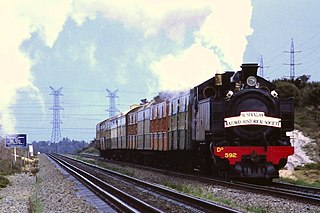
The WAGR Dd class was a class of 4-6-4T tank locomotive operated by the Western Australian Government Railways (WAGR) between 1946 and 1972.
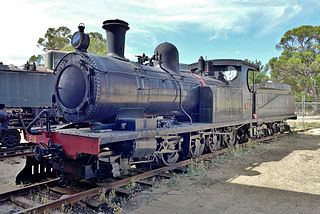
The Western Australian Government Railways (WAGR) O Class was a class consisting of fifty-six 2-8-0 steam locomotives which were introduced by the WAGR between 1896 and 1912. Despite them being tender locomotives, they also featured short boiler side tanks for additional water storage. A useful feature for the long distances required by operation on Western Australia's country lines.
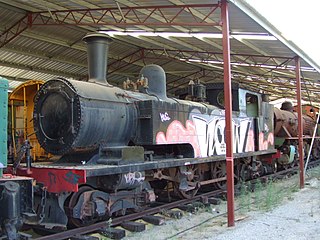
The WAGR N class was a class of steam locomotives operated by the Western Australian Government Railways (WAGR) from 1896 until 1960.
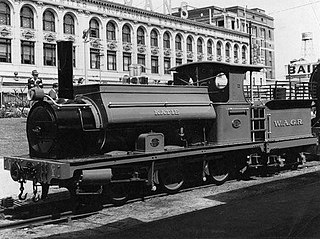
The WAGR C Class was a class of steam locomotives built by Robert Stephenson and Company for the Western Australian Government Railways in 1880 to the same design as the NZR F class.

The WAGR P and Pr classes were two classes of 4-6-2 steam locomotives designed for express passenger service on the Western Australian Government Railways mainline network. The initial designs were prepared by E.S. Race and together the two classes had a total build number of thirty-five locomotives, the P and Pr classes entering service in 1924 and 1938 respectively. Both classes were used on express passenger services, greatly improving the economy and speed of long-distance passenger travel in Western Australia, the results of which were most visible on the Western Australian stage of the Trans-Australian Railway and Westland Express.

The H class was a class of two steam locomotives operated by the Western Australian Government Railways (WAGR) introduced in 1889.

The WAGR Q class was a six-member class of 4-6-2T tank engine steam locomotives operated by the Western Australian Government Railways (WAGR) between 1896 and 1925.
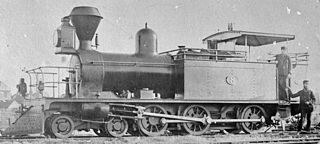
The WAGR B class was a class of 4-6-0T tank locomotives operated by the Western Australian Government Railways (WAGR) between 1884 and 1959.

The WAGR A class was a class of 2-6-0 steam locomotives designed by Beyer, Peacock & Co and operated by the Western Australian Government Railways (WAGR) between 1881 and 1955.

The WAGR D class was a single member class of 0-4-0ST tank locomotive operated by the Western Australian Government Railways (WAGR) from 1884 until 1903.

The Cape Government Railways 1st Class 4-4-0T of 1875 was a South African steam locomotive from the pre-Union era in the Cape of Good Hope.

WAGR G class G233 Leschenault Lady is a preserved 2-6-0 steam locomotive, built in 1898 by James Martin & Co of Gawler, South Australia, for the Western Australian Government Railways (WAGR). It is the third oldest Australian-built steam locomotive still in operational order, after Victorian Railways Y class 112 and WAGR A class 15.






















